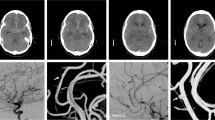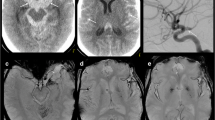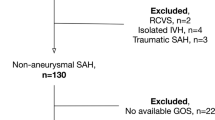Abstract
Purpose
This study aimed to determine the yield of repetitive catheter angiography (digital subtraction angiography (DSA)) for the detection of causative vascular lesions in patients with nontraumatic subarachnoidal hemorrhage (SAH) and negative initial DSA. We hypothesize that a second DSA might be helpful to detect an initially occult bleeding source.
Methods
We retrospectively evaluated 649 patients with acute SAH and invasive catheter angiographies between 2004 and 2012. In 90 SAH patients initial imaging was negative concerning a causative bleeding source. A total of 113 repetitive DSA were performed. Two neuroradiologists reanalyzed the initial imaging and the result of the reangiography independently.
Results
In 4/90 patients (4.5 %) bleeding source was first detected in the second or third DSA. In all other patients, no causative vascular lesion was found. Reasons for the initially false negative diagnostics were one dissecting aneurysm and thrombosis of three aneurysms within the acute phase of SAH.
Conclusions
Repetitive DSA revealed the cause of SAH in 4.5 % of the cases. These findings have a therapeutic and prognostic impact. We think that at least a second DSA should be part of diagnostic work-up in patients with SAH and missing bleeding source, even considering the risk of an additional invasive angiography itself.


Similar content being viewed by others
References
Sacho RH, Dulhanty L, Holland JP, Patel HC. Outcome in patients presenting with an aneurysm related intracerebral haemorrhage in the post-ISAT era. Br J Neurosurg. 2013;27:194–7.
Westerlaan HE, van Dijk MJ, Jansen-van der Weide MC, de Groot JC, Groen RJ, Mooij JJ, et al. Intracranial aneurysms in patients with subarachnoid hemorrhage: CT angiography as a primary examination tool for diagnosis—systematic review and meta-analysis. Radiology. 2011;258:134–45.
Groth M, Forkert ND, Buhk JH, Schoenfeld M, Goebell E, Fiehler J. Comparison of 3D computer-aided with manual cerebral aneurysm measurements in different imaging modalities. Neuroradiology. 2013;55:171–8.
Maslehaty H, Barth H, Petridis AK, Doukas A, Mehdorn MH. Special features of subarachnoid hemorrhage of unknown origin: a review of a series of 179 cases. Neurol Res. 2012;34:91–7.
Nayak S, Kunz AB, Kieslinger K, Ladurner G, Killer M. Classification of non-aneurysmal subarachnoid hemorrhage: CT correlation to the clinical outcome. Clin Radiol. 2010;65:623–8.
Agid R, Andersson T, Almqvist H, Willinsky RA, Lee SK, terBrugge KG, et al. Negative CT angiography findings in patients with spontaneous subarachnoid hemorrhage: when is digital subtraction angiography still needed? AJNR Am J Neuroradiol. 2010;31:696–705.
Ringelstein A, Mueller O, Timochenko O, Moenninghoff C, Sure U, Forsting M, et al. Reangiography after perimesencephalic subarachnoid hemorrhage. Nervenarzt. 2013;84:715–9.
Connolly ES Jr, Rabinstein AA, Carhuapoma JR, Derdeyn CP, Dion J, Higashida RT, et al. American Heart Association Stroke Council: guidelines for the management of aneurysmal subarachnoid hemorrhage: a guideline for healthcare professionals from the American Heart Association/American Stroke Association. Stroke. 2012;43:1711–37.
Diringer MN, Bleck TP, Claude Hemphill J 3rd, Menon D, Shutter L, Vespa P, et al. Neurocritical Care Society: critical care management of patients following aneurysmal subarachnoid hemorrhage: recommendations from the Neurocritical Care Society’s Multidisciplinary Consensus Conference. Neurocrit Care. 2011;15:211–40.
Delgado Almandoz JE, Jagadeesan BD, Refai D, Moran CJ, Cross DT 3rd, Chicoine MR, et al. Diagnostic yield of repeat catheter angiography in patients with catheter- and CT-angiography-negative subarachnoid hemorrhage. Neurosurgery. 2012;70:1135–42.
McKinney AM, Palmer CS, Truwit CL, Karagulle A, Teksam M. Detection of aneurysms by 64-section multidetector CT angiography in patients acutely suspected of having an intracranial aneurysm and comparison with digital subtraction and 3D rotational angiography. AJNR Am J Neuroradiol. 2008;29:594–602.
Westerlaan HE, van Dijk MJ, Jansen-van der Weide MC, de Groot JC, Groen RJ, Mooij JJ, et al. Intracranial aneurysms in patients with subarachnoid hemorrhage: CT angiography as a primary examination tool for diagnosis—systematic review and meta-analysis. Radiology. 2011;258:134–45.
Maslehaty H, Petridis AK, Barth H, Mehdorn HM. Diagnostic value of magnetic resonance imaging in perimesencephalic and nonperimesencephalic subarachnoid hemorrhage of unknown origin. J Neurosurg. 2011;114:1003–7.
Hashimoto H, Iida J, Shin Y, Hironaka Y, Sakaki T. Spinal dural arteriovenous fistula with perimesencephalic subarachnoid haemorrhage. J Clin Neurosci. 2000;7:64–6.
Inamasu J, Nakamura Y, Saito R, Horiguchi T, Kuroshima Y, Mayanagi K, et al. Occult ruptured cerebral aneurysms revealed by repeat angiography: result from a large retrospective study. Clin Neurol Neurosurg. 2003;106:33–7.
Watanabe A, Hirano K, Kamada M, Imamura K, Ishii N, Sekihara Y, et al. Perimesencephalic nonaneurysmal subarachnoid haemorrhage and variations in the veins. Neuroradiology. 2002;44:319–25.
Daenekindt T, Wilms G, Thijs V, Demaerel P, Van Calenbergh F. Variants of the basal vein of Rosenthal and perimesencephalic nonaneurysmal hemorrhage. Surg Neurol. 2008;69:526–9.
Yamakawa H, Ohe N, Yano H, Yoshimura S, Iwama T. Venous drainage patterns in perimesencephalic nonaneurysmal subarachnoid hemorrhage. Clin Neurol Neurosurg. 2008;110:587–91.
Schievink WI, Wijdicks EF. Origin of pretruncal nonaneurysmal subarachnoid hemorrhage: ruptured vein, perforating artery, or intramural hematoma? Mayo Clin Proc. 2000;75:1169–73.
Alen JF, Lagares A, Lobato RD, Gómez PA, Rivas JJ, Ramos A. Comparison between perimesencephalic nonaneurysmal subarachnoid hemorrhage and subarachnoid hemorrhage caused by posterior circulation aneurysms. J Neurosurg. 2003;98:529–35.
Flaherty ML, Haverbusch M, Kissela B, Kleindorfer D, Schneider A, Sekar P, et al. Perimesencephalic subarachnoid hemorrhage: incidence, risk factors, and outcome. J Stroke Cerebrovasc Dis. 2005;14:267–71.
Samaniego EA, Dabus G, Fuentes K, Linfante I. Endovascular treatment of severe vasospasm in nonaneurysmal perimesencephalic subarachnoid hemorrhage. Neurocrit Care. 2011;15:537–41.
Hsu W, Pradilla G, Garonzik IM, Conway JE. Pretruncal nonaneurysmal subarachnoid Hemorrhage causing basilar artery vasospasm. Neurocrit Care. 2010;13:256–60.
Reynolds MR, Blackburn SL, Zipfel GJ. Recurrent idiopathic perimesencephalic subarachnoid hemorrhage. J Neurosurg. 2011;115:612–16.
Marquardt G, Niebauer T, Schick U, Lorenz R. Long-term follow-up after perimesencephalic subarachnoid haemorrhage. J Neurol Neurosurg Psychiatry. 2000;69:127–30.
Inui Y, Oiwa Y, Terada T, Nakakita K, Kamei I, Hayashi S. De novo vertebral artery dissecting aneurysm after contralateral vertebral artery occlusion—two case reports. Neurol Med Chir. 2006;46:32–6.
Sure U, Becker R, Petermeyer M, Bertalanffy H. Aneurysm of the posterior inferior cerebellar artery caused by a traumatic perforating artery tear-out mechanism in a child. Childs Nerv Syst. 1999;25:354–56.
Kaufmann TJ, Huston 3rd J, Mandrekar JN, Schleck CD, Thielen KR, Kallmes DF. Complications of diagnostic cerebral angiography: evaluation of 19,826 consecutive patients. Radiology. 2007;243:812–19.
Author information
Authors and Affiliations
Corresponding author
Rights and permissions
About this article
Cite this article
Ringelstein, A., Mueller, O., Goericke, S. et al. Benefit of Second Catheter Angiography in Patients with Nontraumatic Subarachnoidal Hemorrhage. Clin Neuroradiol 25, 13–17 (2015). https://doi.org/10.1007/s00062-013-0271-5
Received:
Accepted:
Published:
Issue Date:
DOI: https://doi.org/10.1007/s00062-013-0271-5




